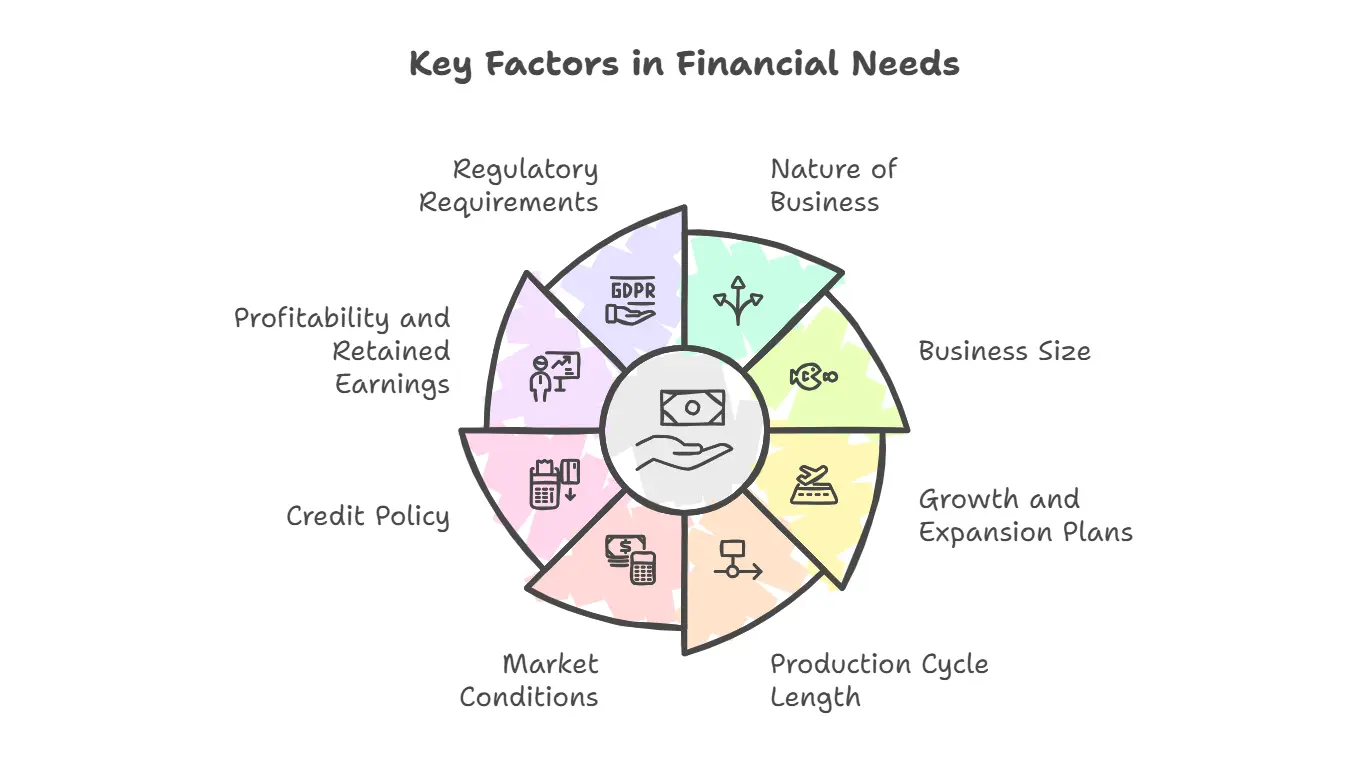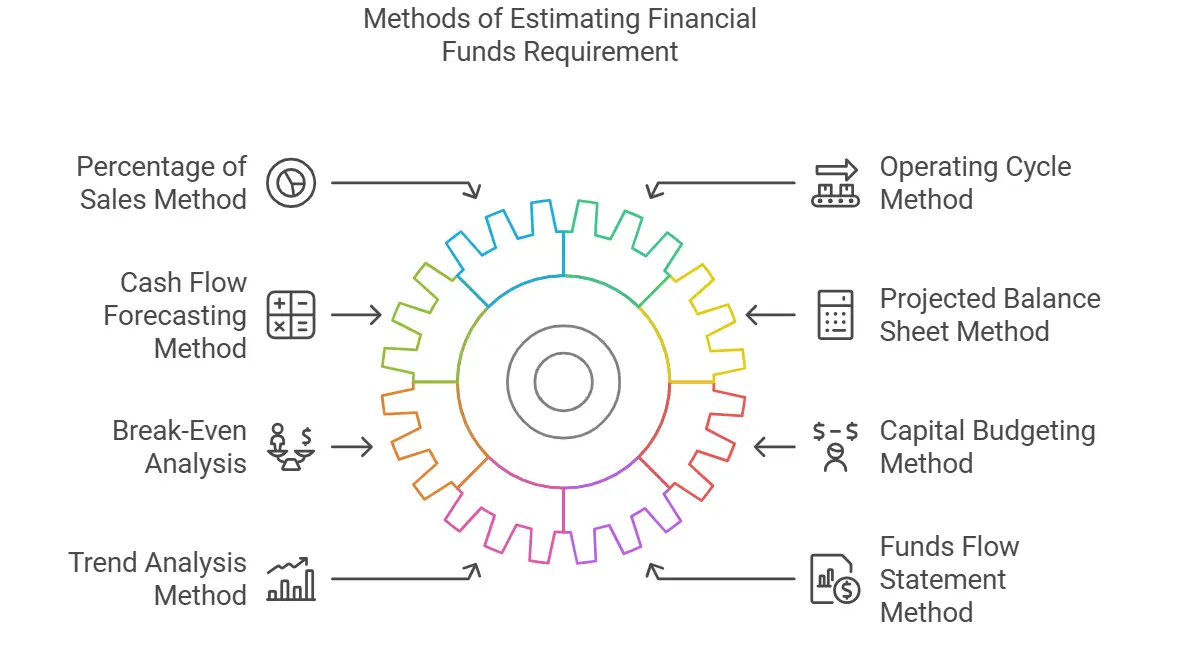Estimating financial funds requirements is a fundamental aspect of business planning and management. It involves assessing the amount of capital an organization needs to meet its operational and strategic objectives. Accurate estimation ensures optimal allocation of resources, avoids financial distress, and facilitates sustainable growth. This article explores the various factors influencing financial needs and the methods employed to estimate them, providing a comprehensive understanding for postgraduate-level learners.
Factors Influencing Financial Funds Requirement
Financial needs vary across organizations due to multiple factors. These determinants shape the capital requirements based on the business’s nature, operations, and external environment.

1. Nature of Business
The nature of the business is one of the primary factors affecting financial requirements. Capital-intensive businesses, such as manufacturing, require significant funds to invest in machinery, equipment, and production facilities. On the other hand, service-oriented businesses like consulting or IT firms may have lower capital needs but higher operating expenses. For example, a manufacturing company producing automobiles will need substantial capital for assembly lines, while a digital marketing agency may prioritize funds for employee salaries and software tools.
2. Business Size
The size of the business directly correlates with financial requirements. Larger organizations typically have more extensive operations, larger workforces, and higher inventory needs, all of which demand greater capital. Conversely, small and medium-sized enterprises (SMEs) often have limited capital requirements but may face challenges in accessing funding. For instance, a multinational corporation (MNC) entering multiple markets may need billions in investments, while a local retailer may require only a fraction of that amount.
3. Growth and Expansion Plans
Companies pursuing growth or expansion strategies require additional funds for infrastructure development, marketing campaigns, hiring, and research and development (R&D). Whether it’s launching a new product, entering a new market, or acquiring another company, growth initiatives significantly impact financial needs. For example, a startup planning to scale operations from one city to multiple cities will need increased funding to support the expansion.
4. Production Cycle Length
The duration of the production cycle plays a crucial role in determining financial requirements. Businesses with longer production cycles need more funds to maintain inventory, pay for raw materials, and cover operating costs until products are sold. For example, a winery with a production cycle of several months will need more working capital than a fast-food restaurant with a short production cycle.
5. Market Conditions
Economic and market conditions influence the cost of operations and capital requirements. Factors like inflation, interest rates, and consumer demand significantly affect financial planning. For instance, during an inflationary period, businesses may need additional funds to cope with rising costs of raw materials and wages.
6. Credit Policy
A company’s credit policy impacts its working capital requirements. Businesses that extend generous credit terms to customers may need additional funds to bridge the gap between sales and collections. Conversely, firms that operate on a cash basis may have lower working capital needs. For example, a wholesale distributor offering a 90-day credit period will require higher working capital than a retailer operating on a cash-and-carry model.
7. Profitability and Retained Earnings
Highly profitable businesses with substantial retained earnings can fund their operations and growth internally, reducing their reliance on external financing. Conversely, companies with low profitability often depend on loans or equity financing to meet their financial needs.
8. Regulatory Requirements
Certain industries are subject to strict regulatory frameworks that necessitate additional financial resources. For example, pharmaceutical companies must comply with rigorous quality standards and testing protocols, increasing their capital requirements.
Methods of Estimating Financial Funds Requirement
Various methods are used to estimate financial funds requirements, each tailored to specific business contexts and objectives. These methods help organizations predict their capital needs and allocate resources efficiently.

1. Percentage of Sales Method
This method estimates financial requirements as a fixed percentage of projected sales. It is based on the assumption that financial needs grow proportionally with sales.
Example: A company expects its sales to increase by 20% in the next fiscal year and determines that 15% of sales will be required as additional funds. If current sales are ₹10 crore, the estimated funds required will be ₹1.5 crore.
2. Operating Cycle Method
The operating cycle represents the time taken to convert raw materials into finished goods and collect receivables from customers. The longer the operating cycle, the higher the financial requirement.
Formula:
Funds Required = (Raw Material + Work-in-Progress + Finished Goods + Receivables) – Payables
For instance, a furniture manufacturer with a 90-day operating cycle will need more funds than a grocery retailer with a 30-day cycle.
3. Cash Flow Forecasting Method
Cash flow forecasting involves estimating cash inflows and outflows over a specific period. This method identifies potential shortfalls or surpluses in liquidity, enabling businesses to plan their financial needs.
Example: A company anticipates monthly cash inflows of ₹5 lakh and outflows of ₹7 lakh. The shortfall of ₹2 lakh indicates the need for additional funding.
4. Projected Balance Sheet Method
This method requires preparing a projected balance sheet for the upcoming financial period, estimating assets, liabilities, and equity. The difference between total assets and liabilities determines the financial requirement.
Example: If a company’s projected assets are ₹50 lakh and liabilities are ₹40 lakh, the additional funds required would be ₹10 lakh.
5. Break-Even Analysis
Break-even analysis focuses on determining the point at which total revenues equal total costs. It is useful for estimating funds required to cover fixed and variable costs until the break-even point is reached.
Example: A startup calculates its break-even sales at ₹20 lakh. Funds are needed to cover costs until sales reach this level.
6. Capital Budgeting Method
This method estimates long-term financial requirements for capital investments, such as purchasing equipment or setting up new facilities. Techniques like Net Present Value (NPV), Internal Rate of Return (IRR), and Payback Period are used to assess funding needs.
Example: A manufacturing firm plans to invest ₹1 crore in new machinery. Capital budgeting techniques help determine the feasibility and funding requirements of the investment.
7. Trend Analysis Method
Historical financial data is analyzed to predict future funding requirements. This method assumes that past growth patterns and trends will continue.
Example: A company experiencing a consistent annual growth rate of 10% uses this trend to estimate its future financial needs.
8. Funds Flow Statement Method
Funds flow statements evaluate the movement of funds within the business by analyzing sources (e.g., loans, equity) and applications (e.g., asset purchases, debt repayment). This method helps identify the financial requirements for upcoming operations and investments.
Example: A company observes that its funds flow statement shows a deficit of ₹5 lakh, indicating the need for additional financing.
Practical Application of Factors and Methods
To better understand the interplay between factors and methods, consider a real-world scenario of an e-commerce startup planning to expand its operations.
Scenario: E-Commerce Startup Expansion
- Factors:
- Nature of Business: Technology-driven with significant marketing and inventory costs.
- Growth Plans: Expanding to 10 new cities.
- Market Conditions: High demand for online shopping, but increasing competition.
- Methods Applied:
- Percentage of Sales: Based on an expected sales growth of 50%, funds needed for inventory and marketing are estimated.
- Cash Flow Forecasting: Monthly cash flow statements identify shortfalls during the initial expansion phase.
- Capital Budgeting: Used to evaluate investment in technology infrastructure and warehouse facilities.
Importance of Accurate Estimation
Accurate estimation of financial funds requirements is critical for:
- Avoiding Financial Crises: Prevents situations where the business runs out of funds.
- Ensuring Optimal Resource Allocation: Helps prioritize investments in profitable areas.
- Enhancing Investor Confidence: Provides clarity to investors and lenders about financial planning.
- Supporting Strategic Decisions: Aligns financial planning with long-term business goals.
- Managing Risk: Identifies potential risks related to liquidity and cash flow shortfalls.
For More Content Check Out :- KMBN 302
Conclusion
Estimating financial funds requirement is an indispensable part of business strategy and planning. By understanding the factors influencing financial needs and employing appropriate estimation methods, organizations can ensure financial stability and sustained growth. The combination of quantitative techniques like percentage of sales, operating cycle analysis, and cash flow forecasting, alongside qualitative insights into market conditions and business goals, enables accurate and effective financial planning. As businesses navigate an increasingly dynamic economic landscape, the ability to estimate financial requirements accurately will remain a cornerstone of successful management.

